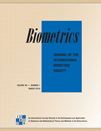Association Models for Clustered Data with Binary and Continuous Responses
Abstract
Summary We consider analysis of clustered data with mixed bivariate responses, i.e., where each member of the cluster has a binary and a continuous outcome. We propose a new bivariate random effects model that induces associations among the binary outcomes within a cluster, among the continuous outcomes within a cluster, between a binary outcome and a continuous outcome from different subjects within a cluster, as well as the direct association between the binary and continuous outcomes within the same subject. For the ease of interpretations of the regression effects, the marginal model of the binary response probability integrated over the random effects preserves the logistic form and the marginal expectation of the continuous response preserves the linear form. We implement maximum likelihood estimation of our model parameters using standard software such as PROC NLMIXED of SAS. Our simulation study demonstrates the robustness of our method with respect to the misspecification of the regression model as well as the random effects model. We illustrate our methodology by analyzing a developmental toxicity study of ethylene glycol in mice.




